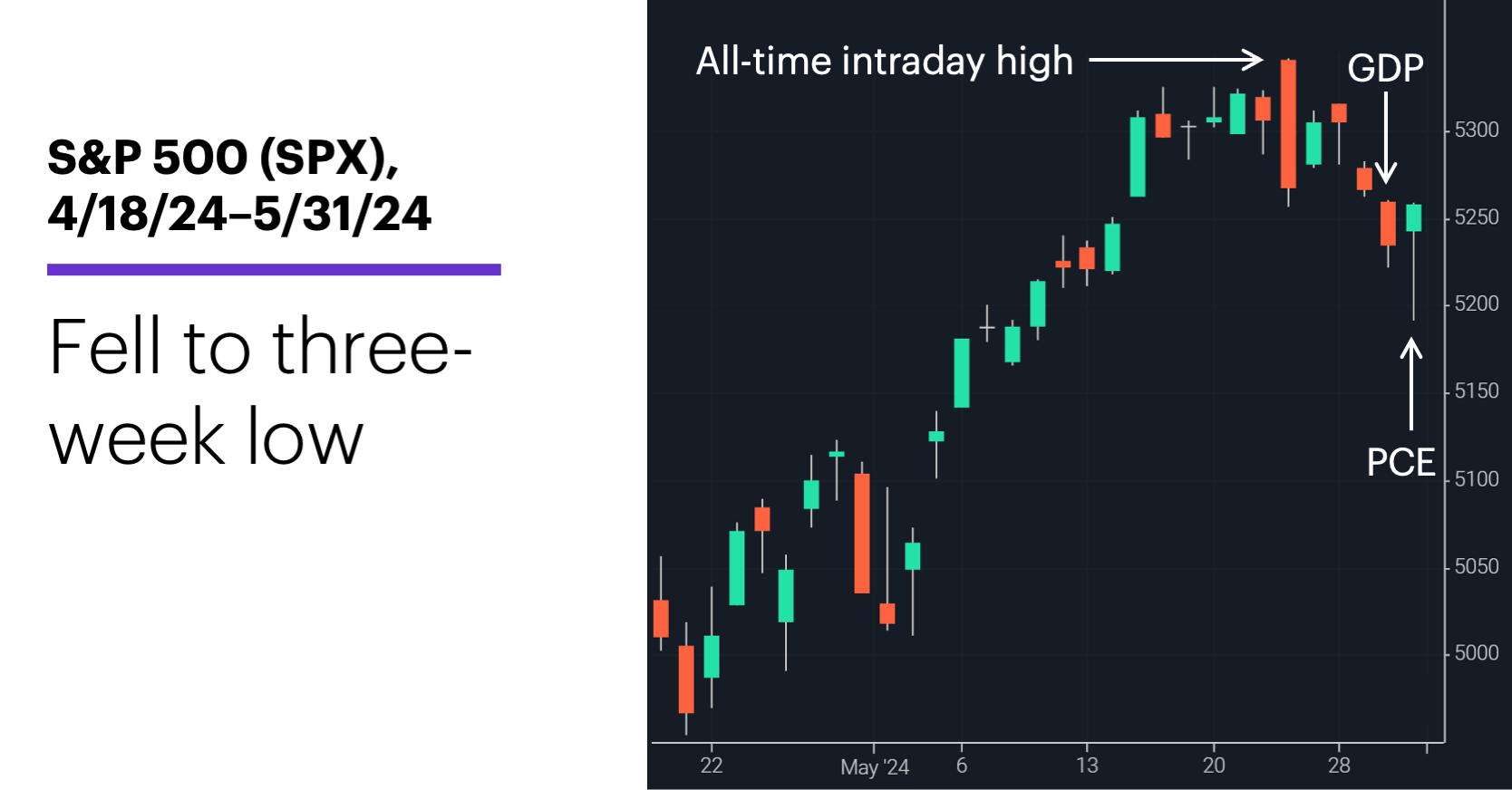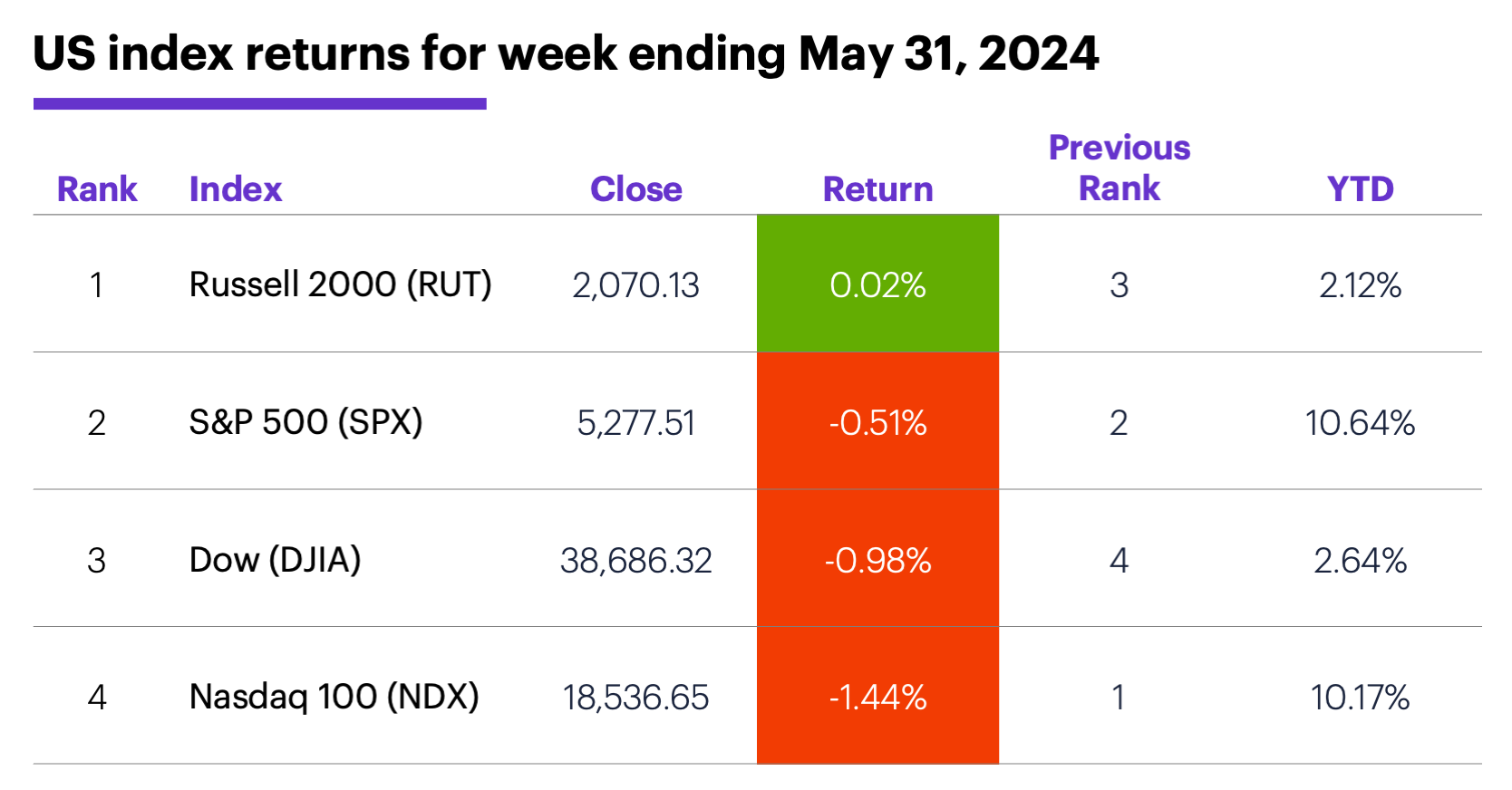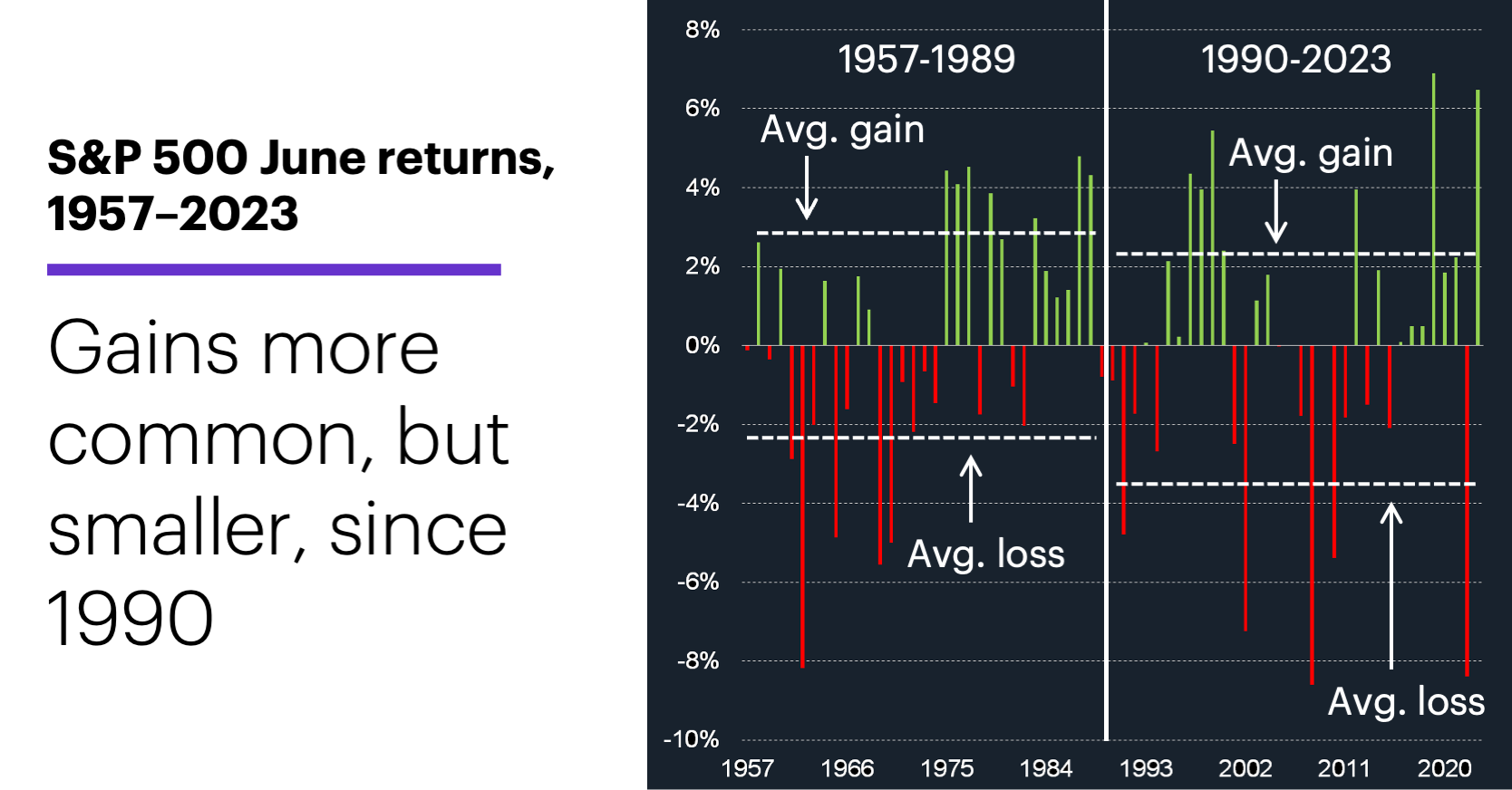Solid May ends with slump
- May’s tech strength slips in final week
- Traders bid up utilities, bond yields swing
- This week: Jobs, manufacturing and services
A strong month for the US market ended on a weak note, as stocks pulled back to a three-week low in a holiday-shortened week.
The S&P 500 (SPX) posted its third-largest May return (+4.8%) of the past two decades despite a net decline in the second half of the month. The SPX fell to its lowest level since May 9 early Friday after a mostly favorable inflation reading from the PCE Price Index, but it rebounded late to close up for the day—although it wasn’t enough to avoid a loss for the week:

Source: Power E*TRADE. (For illustrative purposes. Not a recommendation. Note: It is not possible to invest in an index.)
The headline: Mid-May consolidation turns into late-month pullback.
The fine print: Two weeks ago, the market rode the coattails of the tech sector, which rode the coattails of Nvidia’s (NVDA) breakout to new record highs. Last week initially looked like a rerun, but then the worm turned: NVDA pulled back on Thursday and early Friday, tech followed suit, and the rest of the market appeared to follow tech. Morgan Stanley Wealth Management recently noted the inherent risks of a market that relies on a handful of stocks for the majority of its gains, even if those stocks represent good businesses.1
The number: 0.2%, Friday’s core PCE Price Index reading—in line with estimates and down from 0.3% the previous month. Together with Thursday’s as-expected GDP and weekly jobless claims numbers, last week suggested inflation pressures may have eased, but not dramatically.
The scorecard: The Nasdaq 100 (NDX) tech index took the biggest step back last week, while Russell 2000 (RUT) managed to avoid a loss:

Source (data): Power E*TRADE. (For illustrative purposes. Not a recommendation.)
Sector returns: The strongest S&P 500 sectors last week were utilities (+2.2%), energy (+1.7%), and real estate (+1.7%). The weakest sectors were health care (-1.3%), information technology (-0.8%), and industrials (-0.8%).
Stock movers: Insmed (INSM) +118% to $48.11 on Tuesday, Chewy (CHWY) +27% to $21.50 on Wednesday, Credo Technology (CRDO) +27% to $25.69 on Thursday. On the downside, UiPath (PATH) -34% to $12.07, Nutanix (NTNX) -23% to $56.36 on Thursday.
Futures: July WTI crude oil (CLN4) closed above $80 for the first time since April 30 last Wednesday, but pulled back to end the week with a loss at $76.99. August gold (GCQ4) lost roughly $11 in a mostly sideways week, closing Friday at $2,345.80. Orange juice pulled back after tagging a new all-time high last Tuesday, with the July contract ending the week lower at 437.20. Week’s biggest gains: July cocoa (CCN4) +15.1%, July oats (ZON4) +4.9%. Week’s biggest declines: July natural gas (NGN4) -12%, July cotton (CTN4) -6.8%.
Coming this week
The monthly jobs report headlines a busy first week of June:
●Monday: S&P Global Manufacturing PMI, ISM Manufacturing Index, Construction Spending, auto sales
●Tuesday: Job Openings and Labor Turnover Survey (JOLTS), Factory Orders
●Wednesday: ADP employment change, S&P Global Services PMI, ISM Services Index
●Thursday: Challenger Job Cuts, Productivity and Labor Costs, trade deficit
●Friday: Employment Report, Wholesale Inventories, Consumer Credit
This week’s earnings include:
●Monday: Science Applications (SAIC), Gitlab (GTLB), HealthEquity (HQY)
●Tuesday: CrowdStrike (CRWD), Guidewire Software (GWRE), Hewlett Packard Enterprise (HPE), PVH (PVH), Verint Systems (VRNT)
●Wednesday: Campbell Soup (CPB), Dollar Tree (DLTR), Ollie’s Bargain Outlet (OLLI), Thor Industries (THO), Five Below (FIVE), Lululemon Athletica (LULU), Smartsheet (SMAR), Semtech (SMTC)
●Thursday: Ciena (CIEN), G-III Apparel (GIII), J.M. Smucker (SJM), DocuSign (DOCU), Rent The Runway (RENT)
●Friday: J.Jill (JILL)
Check the Active Trader Commentary each morning for an updated list of earnings announcements, IPOs, economic reports, and other market events.
Junes and swoons
The SPX’s 0% (technically, +0.004%) average June return since 1957 may strike some traders as a good reason to shut down their screens and head to the beach.
Of course, that flat average performance is merely a composite picture of individual returns that have ranged from +6.9% to -8.6%:2

Data source: Power E*TRADE. (For illustrative purposes. Not a recommendation. Note: It is not possible to invest directly in an index.)
June has had a bit of a consistency problem. From 1957-1989, it was positive 16 times and negative 17 times, but that was partially offset by the fact that the average June gain (+2.8%) was bigger than the average June loss (-2.4%).
The picture for 1990-2023 was reversed: June was more frequently an up month (20 out of 34 years, including eight of the past 10), but its average loss (-3.5%) was bigger than its average gain (+2.3%). In fact, five positive Junes during this period had returns of +0.23% or less, while five negative Junes had returns exceeding -4%.
Bottom line, recent history aside, June hasn’t been an up month much more often than it’s been a down one, and it’s hosted its share of notable losses.
Click here to log on to your account or learn more about E*TRADE's trading platforms, or follow the Company on X (Twitter), @ETRADE, for useful trading and investing insights.
1 MorganStanley.com. MorganStanley.com. What if Rates are Higher for Longer? 5/6/24.
2 All figures reflect S&P 500 (SPX) daily prices, May 1971–May 2023. Supporting document available upon request.